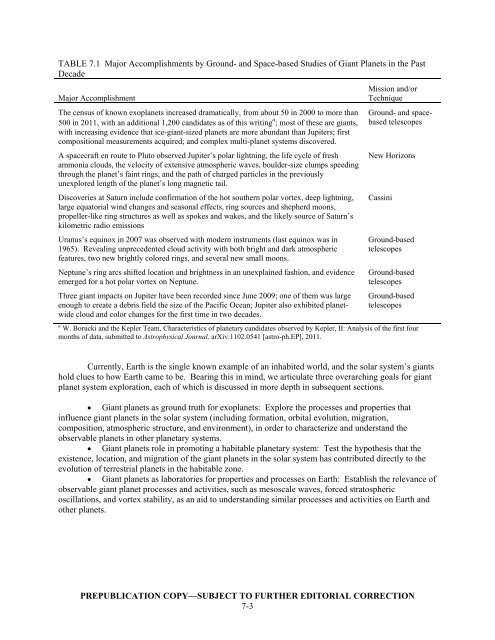Vision and Voyages for Planetary Science in the - Solar System ...
Vision and Voyages for Planetary Science in the - Solar System ...
Vision and Voyages for Planetary Science in the - Solar System ...
You also want an ePaper? Increase the reach of your titles
YUMPU automatically turns print PDFs into web optimized ePapers that Google loves.
TABLE 7.1 Major Accomplishments by Ground- <strong>and</strong> Space-based Studies of Giant Planets <strong>in</strong> <strong>the</strong> Past<br />
Decade<br />
Major Accomplishment<br />
The census of known exoplanets <strong>in</strong>creased dramatically, from about 50 <strong>in</strong> 2000 to more than<br />
500 <strong>in</strong> 2011, with an additional 1,200 c<strong>and</strong>idates as of this writ<strong>in</strong>g a ; most of <strong>the</strong>se are giants,<br />
with <strong>in</strong>creas<strong>in</strong>g evidence that ice-giant-sized planets are more abundant than Jupiters; first<br />
compositional measurements acquired; <strong>and</strong> complex multi-planet systems discovered.<br />
A spacecraft en route to Pluto observed Jupiter’s polar lightn<strong>in</strong>g, <strong>the</strong> life cycle of fresh<br />
ammonia clouds, <strong>the</strong> velocity of extensive atmospheric waves, boulder-size clumps speed<strong>in</strong>g<br />
through <strong>the</strong> planet’s fa<strong>in</strong>t r<strong>in</strong>gs, <strong>and</strong> <strong>the</strong> path of charged particles <strong>in</strong> <strong>the</strong> previously<br />
unexplored length of <strong>the</strong> planet’s long magnetic tail.<br />
Discoveries at Saturn <strong>in</strong>clude confirmation of <strong>the</strong> hot sou<strong>the</strong>rn polar vortex, deep lightn<strong>in</strong>g,<br />
large equatorial w<strong>in</strong>d changes <strong>and</strong> seasonal effects, r<strong>in</strong>g sources <strong>and</strong> shepherd moons,<br />
propeller-like r<strong>in</strong>g structures as well as spokes <strong>and</strong> wakes, <strong>and</strong> <strong>the</strong> likely source of Saturn’s<br />
kilometric radio emissions<br />
Uranus’s equ<strong>in</strong>ox <strong>in</strong> 2007 was observed with modern <strong>in</strong>struments (last equ<strong>in</strong>ox was <strong>in</strong><br />
1965). Reveal<strong>in</strong>g unprecedented cloud activity with both bright <strong>and</strong> dark atmospheric<br />
features, two new brightly colored r<strong>in</strong>gs, <strong>and</strong> several new small moons.<br />
Neptune’s r<strong>in</strong>g arcs shifted location <strong>and</strong> brightness <strong>in</strong> an unexpla<strong>in</strong>ed fashion, <strong>and</strong> evidence<br />
emerged <strong>for</strong> a hot polar vortex on Neptune.<br />
Three giant impacts on Jupiter have been recorded s<strong>in</strong>ce June 2009; one of <strong>the</strong>m was large<br />
enough to create a debris field <strong>the</strong> size of <strong>the</strong> Pacific Ocean; Jupiter also exhibited planetwide<br />
cloud <strong>and</strong> color changes <strong>for</strong> <strong>the</strong> first time <strong>in</strong> two decades.<br />
Mission <strong>and</strong>/or<br />
Technique<br />
Ground- <strong>and</strong> spacebased<br />
telescopes<br />
New Horizons<br />
Cass<strong>in</strong>i<br />
Ground-based<br />
telescopes<br />
Ground-based<br />
telescopes<br />
Ground-based<br />
telescopes<br />
a W. Borucki <strong>and</strong> <strong>the</strong> Kepler Team, Characteristics of planetary c<strong>and</strong>idates observed by Kepler, II: Analysis of <strong>the</strong> first four<br />
months of data, submitted to Astrophysical Journal, arXiv:1102.0541 [astro-ph.EP], 2011.<br />
Currently, Earth is <strong>the</strong> s<strong>in</strong>gle known example of an <strong>in</strong>habited world, <strong>and</strong> <strong>the</strong> solar system’s giants<br />
hold clues to how Earth came to be. Bear<strong>in</strong>g this <strong>in</strong> m<strong>in</strong>d, we articulate three overarch<strong>in</strong>g goals <strong>for</strong> giant<br />
planet system exploration, each of which is discussed <strong>in</strong> more depth <strong>in</strong> subsequent sections.<br />
• Giant planets as ground truth <strong>for</strong> exoplanets: Explore <strong>the</strong> processes <strong>and</strong> properties that<br />
<strong>in</strong>fluence giant planets <strong>in</strong> <strong>the</strong> solar system (<strong>in</strong>clud<strong>in</strong>g <strong>for</strong>mation, orbital evolution, migration,<br />
composition, atmospheric structure, <strong>and</strong> environment), <strong>in</strong> order to characterize <strong>and</strong> underst<strong>and</strong> <strong>the</strong><br />
observable planets <strong>in</strong> o<strong>the</strong>r planetary systems.<br />
• Giant planets role <strong>in</strong> promot<strong>in</strong>g a habitable planetary system: Test <strong>the</strong> hypo<strong>the</strong>sis that <strong>the</strong><br />
existence, location, <strong>and</strong> migration of <strong>the</strong> giant planets <strong>in</strong> <strong>the</strong> solar system has contributed directly to <strong>the</strong><br />
evolution of terrestrial planets <strong>in</strong> <strong>the</strong> habitable zone.<br />
• Giant planets as laboratories <strong>for</strong> properties <strong>and</strong> processes on Earth: Establish <strong>the</strong> relevance of<br />
observable giant planet processes <strong>and</strong> activities, such as mesoscale waves, <strong>for</strong>ced stratospheric<br />
oscillations, <strong>and</strong> vortex stability, as an aid to underst<strong>and</strong><strong>in</strong>g similar processes <strong>and</strong> activities on Earth <strong>and</strong><br />
o<strong>the</strong>r planets.<br />
PREPUBLICATION COPY—SUBJECT TO FURTHER EDITORIAL CORRECTION<br />
7-3











